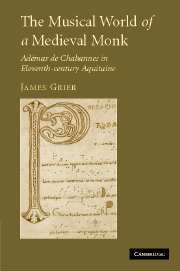Book contents
- Frontmatter
- Contents
- Preface
- A note on the musical examples and the edition
- Chapter 1 Introduction: Adémar de Chabannes and Saint Martial de Limoges
- Chapter 2 Music scribe
- Chapter 3 Compiler
- Chapter 4 Editor
- Chapter 5 Composer
- Chapter 6 Singer
- Chapter 7 Conclusion: The success of the apostolic campaign
- Appendix A Manuscripts with Adémar's music hand
- Appendix B Adémar's original compositions
- Bibliography
- Index of chants
- Index of manuscripts
- General index
- References
Bibliography
Published online by Cambridge University Press: 22 September 2009
- Frontmatter
- Contents
- Preface
- A note on the musical examples and the edition
- Chapter 1 Introduction: Adémar de Chabannes and Saint Martial de Limoges
- Chapter 2 Music scribe
- Chapter 3 Compiler
- Chapter 4 Editor
- Chapter 5 Composer
- Chapter 6 Singer
- Chapter 7 Conclusion: The success of the apostolic campaign
- Appendix A Manuscripts with Adémar's music hand
- Appendix B Adémar's original compositions
- Bibliography
- Index of chants
- Index of manuscripts
- General index
- References
- Type
- Chapter
- Information
- The Musical World of a Medieval MonkAdémar de Chabannes in Eleventh-century Aquitaine, pp. 336 - 358Publisher: Cambridge University PressPrint publication year: 2006



